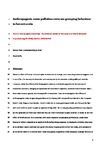Anthropogenic noise pollution reverses grouping behaviour in hermit crabs
| dc.contributor.author | Tidau, Svenja | |
| dc.contributor.author | Briffa, Mark | |
| dc.date.accessioned | 2019-06-24T10:18:43Z | |
| dc.date.available | 2019-06-24T10:18:43Z | |
| dc.date.issued | 2019-05 | |
| dc.identifier.issn | 0003-3472 | |
| dc.identifier.issn | 1095-8282 | |
| dc.identifier.uri | http://hdl.handle.net/10026.1/14367 | |
| dc.description.abstract |
Noise is a form of human-induced rapid environmental change, and mounting evidence suggests that it can affect the sensory environment and consequently the decision-making ability of animals. However, while the effects of anthropogenic noise on individual organisms in the context of movement patterns, foraging and predation risk have been reported, relatively little is known about how noise impacts groups and intraspecific interactions. Here we investigated the effects of anthropogenic noise on grouping preference (i.e. being with conspecifics or alone) in the European hermit crab, Pagurus bernhardus. Hermit crabs live in empty gastropod shells and frequently fight with each other to gain an optimal-fitting shell. Thus, crabs' grouping preference may depend on the optimality of their own shell and thus on their motivation to gain another. To test the effect of shell size and its interaction with noise exposure on grouping preferences, crabs were housed in either suboptimal or optimal shells before being exposed to playbacks of either ship noise or an ambient sound (control) and given the choice to group with one or five conspecifics or to remain alone in a neutral zone. Crabs occupying suboptimal shells had a longer latency to enter the zone with a single crab than crabs in optimal shells. This difference was only seen in the ambient sound treatment, disappearing completely under ship noise. Under ambient sound, crabs in optimal shells spent most of their time close to a single crab, while crabs in suboptimal shells showed no clear preference. However, exposure to ship noise reversed the effect of shell quality on grouping preference. Our results demonstrate that exposure to anthropogenic noise can alter not only individual behaviour but also social behaviour. | |
| dc.format.extent | 113-120 | |
| dc.language | en | |
| dc.language.iso | en | |
| dc.publisher | Elsevier Masson | |
| dc.subject | anthropogenic noise | |
| dc.subject | environmental change | |
| dc.subject | grouping preference | |
| dc.subject | hermit crabs | |
| dc.subject | intraspecific interaction | |
| dc.subject | sensory environment | |
| dc.title | Anthropogenic noise pollution reverses grouping behaviour in hermit crabs | |
| dc.type | journal-article | |
| dc.type | Journal Article | |
| plymouth.author-url | https://www.webofscience.com/api/gateway?GWVersion=2&SrcApp=PARTNER_APP&SrcAuth=LinksAMR&KeyUT=WOS:000467013300011&DestLinkType=FullRecord&DestApp=ALL_WOS&UsrCustomerID=11bb513d99f797142bcfeffcc58ea008 | |
| plymouth.volume | 151 | |
| plymouth.publication-status | Published | |
| plymouth.journal | Animal Behaviour | |
| dc.identifier.doi | 10.1016/j.anbehav.2019.03.010 | |
| plymouth.organisational-group | /Plymouth | |
| plymouth.organisational-group | /Plymouth/Faculty of Science and Engineering | |
| plymouth.organisational-group | /Plymouth/Faculty of Science and Engineering/School of Biological and Marine Sciences | |
| plymouth.organisational-group | /Plymouth/REF 2021 Researchers by UoA | |
| plymouth.organisational-group | /Plymouth/REF 2021 Researchers by UoA/UoA04 Psychology, Psychiatry and Neuroscience | |
| plymouth.organisational-group | /Plymouth/Research Groups | |
| plymouth.organisational-group | /Plymouth/Research Groups/Marine Institute | |
| plymouth.organisational-group | /Plymouth/Users by role | |
| plymouth.organisational-group | /Plymouth/Users by role/Academics | |
| plymouth.organisational-group | /Plymouth/Users by role/Researchers in ResearchFish submission | |
| dcterms.dateAccepted | 2019-02-14 | |
| dc.rights.embargodate | 2020-4-10 | |
| dc.identifier.eissn | 1095-8282 | |
| dc.rights.embargoperiod | Not known | |
| rioxxterms.versionofrecord | 10.1016/j.anbehav.2019.03.010 | |
| rioxxterms.licenseref.uri | http://www.rioxx.net/licenses/all-rights-reserved | |
| rioxxterms.licenseref.startdate | 2019-05 | |
| rioxxterms.type | Journal Article/Review |


